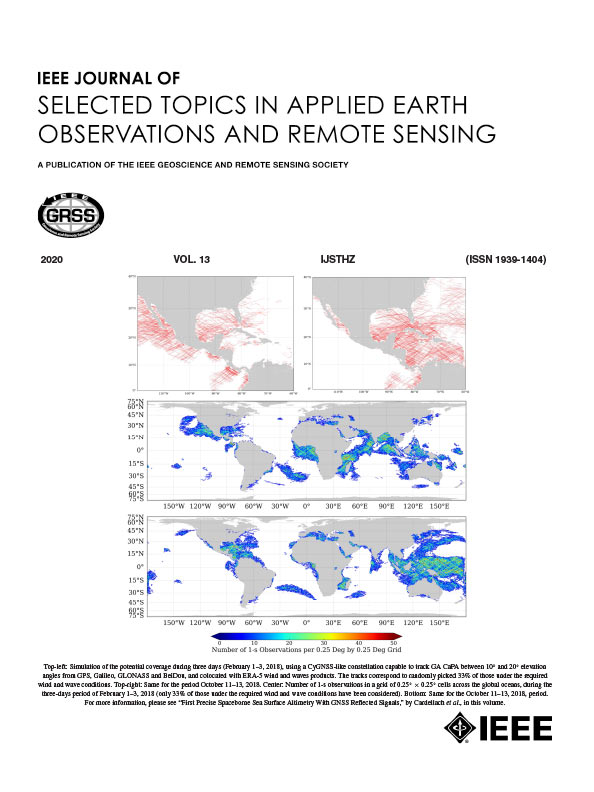基于机器学习的卫星光谱数据中云滴数浓度和液态水路径的检索
IF 5.3
2区 地球科学
Q1 ENGINEERING, ELECTRICAL & ELECTRONIC
IEEE Journal of Selected Topics in Applied Earth Observations and Remote Sensing
Pub Date : 2025-08-22
DOI:10.1109/JSTARS.2025.3601981
引用次数: 0
摘要
准确估计云的微物理性质,特别是云滴数浓度($N_{\ mathm {d}}$)和液态水路径($L$),对于提高我们对气溶胶-云相互作用(ACI)的理解至关重要。这些变量的传统卫星检索依赖于经常导致系统误差的假设。在这项研究中,我们提出了一个机器学习(ML)框架,可以直接从卫星光谱反射率和辐射数据中预测$N_{\ mathm {d}}$和$L$,从而绕过了检索算法中的传统假设。我们使用来自icosterdral非流体静力大涡模拟和中等分辨率成像光谱辐射仪的光谱通道的数据,使用传统的统计技术和ML可解释性方法来评估光谱特征的相关性。我们的研究结果表明,使用神经网络模型,可以使用三个光谱通道准确预测$L$,确定系数($R^{2}$)为0.93,标准化平均绝对误差(nMAE)约为16%。$N_{\ mathm {d}}$的预测需要7个通道,实现$R^{2}$为0.76,nMAE约为26%。正如预期的那样,$N_{\ mathm {d}}$需要比$L$更丰富的谱表示。我们的机器学习方法通过避免与中间检索变量相关的假设,可以更直接、更灵活地估计云属性。该框架提供了对光谱敏感性的新见解,并支持从卫星观测中对ACI进行另一种可能更可靠的评估,可能导致气候模式约束的改进。本文章由计算机程序翻译,如有差异,请以英文原文为准。
Machine Learning-Based Retrieval of Cloud Droplet Number Concentration and Liquid Water Path From Satellite Spectral Data
Accurate estimation of cloud microphysical properties, particularly the cloud droplet number concentration ($N_{\mathrm{d}}$ $L$ $N_{\mathrm{d}}$ $L$ $L$ $R^{2}$ $N_{\mathrm{d}}$ $R^{2}$ $N_{\mathrm{d}}$ $L$
求助全文
通过发布文献求助,成功后即可免费获取论文全文。
去求助
来源期刊
CiteScore
9.30
自引率
10.90%
发文量
563
审稿时长
4.7 months
期刊介绍:
The IEEE Journal of Selected Topics in Applied Earth Observations and Remote Sensing addresses the growing field of applications in Earth observations and remote sensing, and also provides a venue for the rapidly expanding special issues that are being sponsored by the IEEE Geosciences and Remote Sensing Society. The journal draws upon the experience of the highly successful “IEEE Transactions on Geoscience and Remote Sensing” and provide a complementary medium for the wide range of topics in applied earth observations. The ‘Applications’ areas encompasses the societal benefit areas of the Global Earth Observations Systems of Systems (GEOSS) program. Through deliberations over two years, ministers from 50 countries agreed to identify nine areas where Earth observation could positively impact the quality of life and health of their respective countries. Some of these are areas not traditionally addressed in the IEEE context. These include biodiversity, health and climate. Yet it is the skill sets of IEEE members, in areas such as observations, communications, computers, signal processing, standards and ocean engineering, that form the technical underpinnings of GEOSS. Thus, the Journal attracts a broad range of interests that serves both present members in new ways and expands the IEEE visibility into new areas.

 求助内容:
求助内容: 应助结果提醒方式:
应助结果提醒方式:


